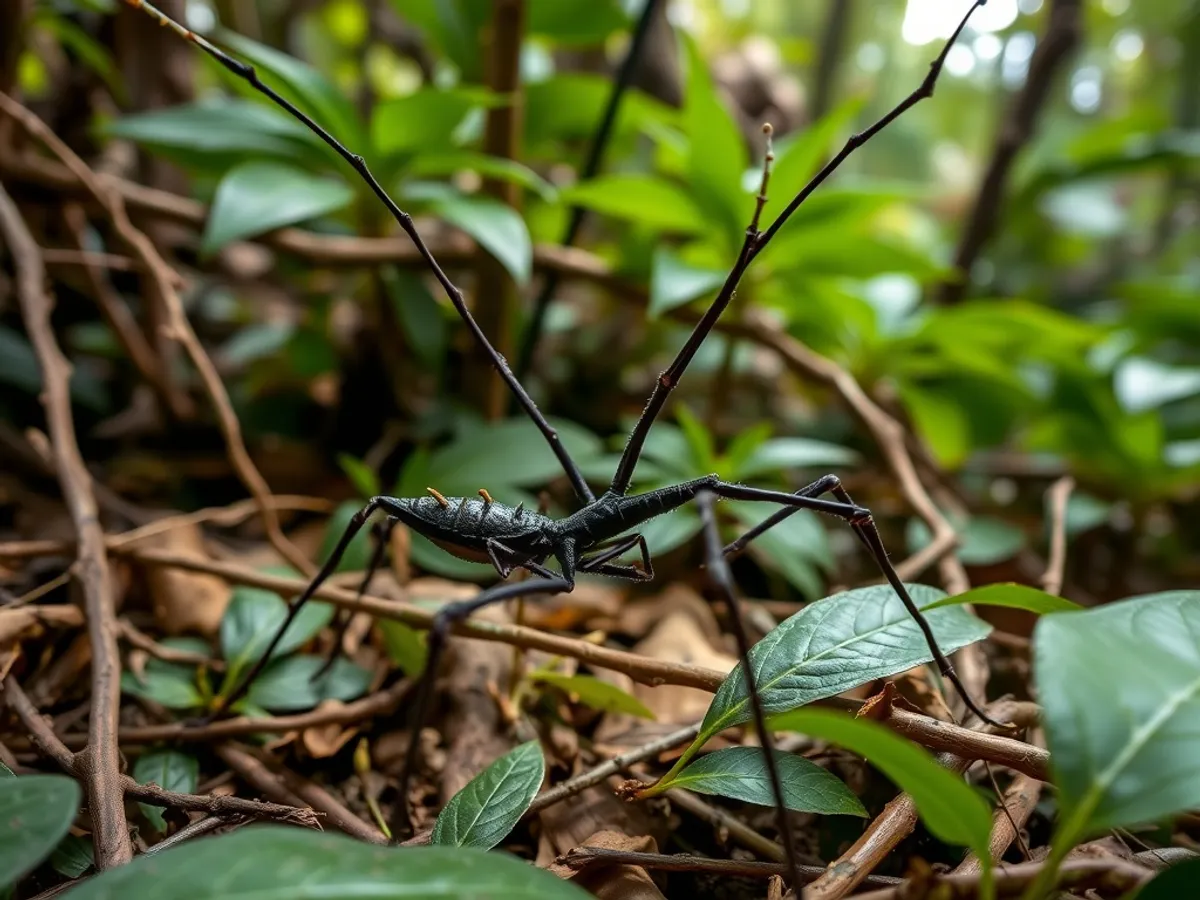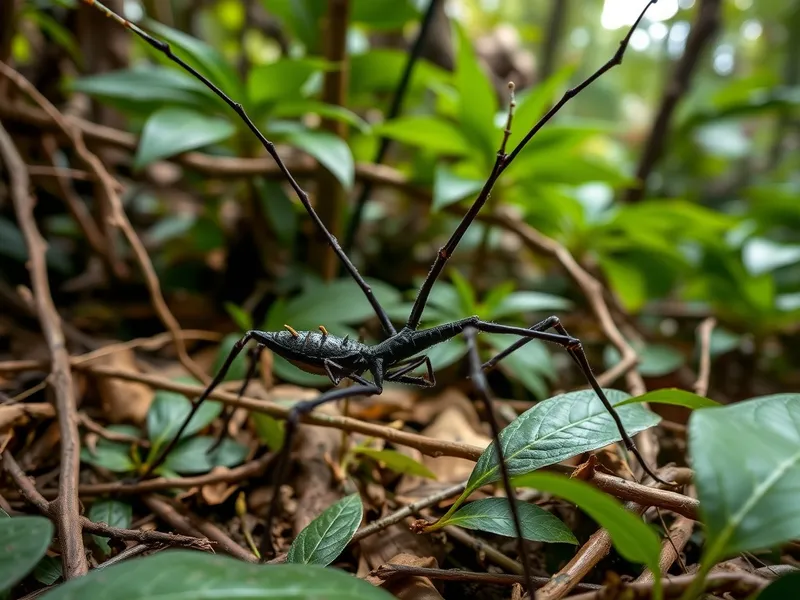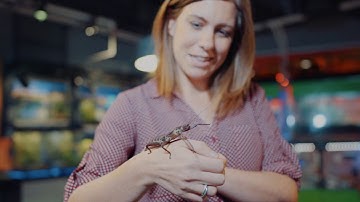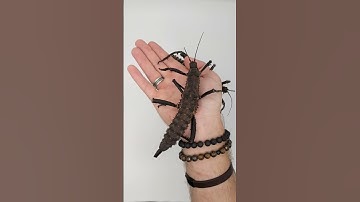
Thorny Devil Stick Insect
Eurycantha calcarata

Meet the Thorny Devil Stick Insect
The Thorny Devil Stick Insect is a large, robust species of stick insect native to the rainforests of Papua New Guinea. Its body is heavily armored with spines and tubercles, providing excellent camouflage among thorny vegetation and deterring predators. Males possess a prominent spur on their hind legs, which is used in defense and during mating battles. These nocturnal insects are expert climbers and rely on their cryptic appearance to blend seamlessly with branches and leaves.
Classification
Invertebrate
Habitat
Tropical rainforest undergrowth
Diet
Herbivore
Lifespan
1-2 years
Conservation
Least Concern
Weight
20-35 grams
📖Fascinating Facts
Impressive Camouflage
Their thorn-covered bodies help them resemble sticks or pieces of bark, making them nearly invisible to predators in their natural rainforest habitat.
Defensive Spurs
Males are equipped with sharp spurs on their hind legs, which they use to defend themselves and compete for mates.
Egg-Laying Experts
Females can lay up to 100 eggs at a time, often burying them in soil where they may take up to a year to hatch.
📋Detailed Description
Eurycantha calcarata, commonly known as the Thorny Devil Stick Insect or Giant Spiny Stick Insect, is a large phasmid species endemic to the rainforests of Papua New Guinea and surrounding islands. Adults typically measure between 12–15 cm in length, with females being larger and more robust than males. The body is heavily armored with pronounced spines and tubercles, especially along the thorax and femora, providing both physical defense and effective camouflage among the thorny undergrowth. The coloration ranges from mottled brown to greenish hues, further enhancing their cryptic appearance. Males are distinguished by a prominent, curved spur (calcar) on the hind femora, which is used in intraspecific combat and defense. The head is short and broad, with strong mandibles adapted for chewing tough leaves. Eurycantha calcarata is primarily nocturnal, remaining motionless and well-hidden during the day and becoming active at night to feed. Their legs are strong and adapted for climbing, enabling them to navigate dense vegetation. When threatened, they may display thanatosis (playing dead), raise their spiny legs defensively, or emit a faint musky odor as a deterrent. The species exhibits sexual dimorphism, with females being wingless and heavier, while males are more slender but also wingless.
💡 Did you know?
The males' hindleg spurs can deliver a painful pinch if threatened, making them one of the few stick insects with notable defensive adaptations.
🔬Research & Sources
Wikipedia Summary
Eurycantha calcarata is a species of phasmid endemic to Australasia.
Last Modified: 8/15/2024
🎭Behavior & Social Structure
Thorny Devil Stick Insects are solitary and primarily nocturnal, spending daylight hours concealed in leaf litter or clinging motionless to branches. At night, they emerge to feed on a variety of broad-leaved plants, including bramble, guava, and various rainforest shrubs. Feeding is slow and deliberate, with individuals using their strong mandibles to chew through tough foliage. Males may exhibit territorial behavior, especially during the breeding season, engaging in ritualized combat using their spurred hind legs. When disturbed, both sexes may adopt a defensive posture, raising their spiny legs and arching the abdomen to deter predators. Thanatosis (death-feigning) is also observed as an anti-predator strategy. Social interactions are minimal outside of mating, and there is no evidence of cooperative behavior or group living.
👶Reproduction & Life Cycle
Eurycantha calcarata is oviparous, with reproduction occurring year-round in the stable tropical climate, though peaks may coincide with the wet season. Mating involves the male mounting the female and using his spurred hind legs to grasp her securely, sometimes resulting in visible scars on the female's thorax. Copulation can last several hours. Females lay large, oval eggs (approximately 6–8 mm long) by burying them in moist soil or leaf litter using their ovipositor. Incubation lasts 4–6 months, depending on temperature and humidity. Nymphs hatch resembling miniature adults and undergo 5–6 molts (instars) before reaching maturity, a process that can take 8–12 months. There is no parental care; eggs and nymphs are left to develop independently.
🛡️Adaptations & Survival
Eurycantha calcarata exhibits several notable adaptations for survival in dense rainforest environments. The spiny exoskeleton provides both camouflage and physical protection from predators such as birds, reptiles, and small mammals. Their cryptic coloration and irregular body outline mimic twigs and thorny branches, making them difficult to detect. Thanatosis and defensive leg-raising further reduce predation risk. The male's femoral spur is a specialized weapon for intraspecific competition and defense. Their strong, clawed legs are adapted for climbing and gripping rough surfaces. As strict herbivores, they possess robust mandibles for processing tough plant material. The ability to lay eggs in concealed locations helps protect offspring from predation and desiccation.
🎨Cultural Significance
While Eurycantha calcarata does not hold major significance in traditional mythology or folklore, it is well known among indigenous communities and is sometimes used as a teaching tool for children about rainforest biodiversity. In recent years, it has gained popularity in the exotic pet trade and as a model organism in educational programs and public insect exhibits due to its impressive size and unique appearance. Its striking morphology and defensive behaviors have made it a subject of interest in natural history displays and documentaries.
🔬Recent Research & Discoveries
Recent research has focused on the biomechanics of Eurycantha calcarata's defensive behaviors, particularly the use of femoral spurs in male-male combat and predator deterrence. Studies on their reproductive biology have provided insights into phasmid egg-laying strategies and embryonic development. Genetic analyses are being conducted to clarify phylogenetic relationships within the Lonchodidae family. There is ongoing interest in their role as herbivores in rainforest ecosystems, including their impact on plant community dynamics. Captive breeding programs have contributed to a better understanding of their life cycle, dietary preferences, and environmental requirements.
🎥Wildlife Videos

Thorny Devil Stick Insect | WEIRD ANIMALS
Eurycantha calcarata common known as the Thorny devil stick insect or the Giant spiny stick insect is a species of phasmid ...
Lion Mountain TV

Meet the Thorny Devil Stick Insect | Discovery Place Science
Meet the Thorny Devil Stick Insect who lives in the Explore More Life lab at Discovery Place Science. More info on our animals: ...
Discovery Place Science

Thorny Devil / Eurycantha Calcarata / Stick Insect
Eurycantha calcarata (common names thorny devil stick insect and giant spiny stick insect is a species of stick insect endemic to ...
T3 Times

Bug Out - The New Guinea Spiny Devil Stick Insect
Ayla from Entomica teaches us about the New Guinea Spiny Devil Stick Insect. Also known as: "The Land Lobster".
ShawTVSSM

The mighty thorny devil stick insect. #eurycanthahorrida #insects #biology #nature #animals
Phasmedia

Thorny devil stick insect
The biggest and coolest bug I have ever seen. Kelly loved it!
CraigBartolomei
🌍Habitat Information
The Thorny Devil Stick Insect typically inhabits Tropical rainforest undergrowth environments. Thorny Devil Stick Insects have adapted to their environments with specialized features and behaviors.
Primary Habitat:
Tropical rainforest undergrowth
More detailed habitat information will be available soon.
🛡️Conservation Status
The Thorny Devil Stick Insect is currently classified as Least Concern. Conservation efforts are crucial for preserving this species for future generations.
Common Threats:
- 🏠Habitat loss and fragmentation
- 🌡️Climate change impacts
- 🎯Hunting and poaching
- 🏭Human-wildlife conflict
⚠️Threats & Conservation Challenges
Currently, Eurycantha calcarata is classified as Least Concern, with stable populations throughout its range. However, localized threats include habitat loss due to deforestation, agricultural expansion, and logging in Papua New Guinea. Collection for the pet trade is monitored but not considered a significant threat at present. Climate change poses a potential long-term risk by altering rainforest microclimates and plant communities. Natural predators include birds, rodents, and reptiles, but their effective camouflage and defensive adaptations mitigate predation pressure. Conservation efforts focus on habitat preservation and sustainable management of rainforest ecosystems.
🔬Scientific Classification
Scientific Name
Eurycantha calcarata
Classification Hierarchy
🔍 About Taxonomic Classification
Taxonomic classification is a hierarchical system used by scientists to classify and organize living organisms based on shared characteristics and evolutionary relationships.
The system moves from broad categories (Kingdom) to increasingly specific ones, with each animal's scientific name typically consisting of its Genus and species.
📝Community Notes
Share your observations and insights about the Thorny Devil Stick Insect with our community of wildlife enthusiasts.
Join Our Community
Sign in to share your observations and connect with fellow wildlife enthusiasts.
Sign In to ContributeNo community notes yet
Be the first to share your observations about the Thorny Devil Stick Insect!
Explore Thorny Devil Stick Insect
Select a tab above to learn more about this amazing animal.
📸Photo Gallery
No photos available for this animal yet.
🌟Discover More Wildlife
Continue your journey of discovery with more fascinating animals from our database
